Chapter: Compilers : Principles, Techniques, & Tools : Intermediate-Code Generation
Backpatching
Backpatching
1 One-Pass Code Generation Using
Backpatching
2 Backpatching for Boolean Expressions
3 Flow-of-Control Statements
4 Break-, Continue-, and Goto-Statements
5 Exercises for Section 6.7
A key problem when generating
code for boolean expressions and flow-of-control statements is that of matching
a jump instruction with the target of the jump For example, the translation of
the boolean expression B in if ( B ) S
contains a jump, for when B is false, to the instruction following the code for
S. In a one-pass translation, B must be translated before S is examined. What
then is the target of the goto that jumps over the code for S? In Section 6.6 we addressed this
problem by passing labels as inherited attributes to where the relevant jump
instructions were generated. But a separate pass is then needed to bind labels
to addresses.
This section takes a complementary approach, called backpatching, in which lists of jumps are passed as synthesized
attributes. Specifically, when a jump is
generated, the target of the jump
is temporarily left
unspecified. Each such jump is put on a list of jumps whose labels are to be filled in when the proper label can
be determined. All of the jumps on a list have the same target label.
1. One-Pass Code Generation Using
Backpatching
Backpatching can be used to
generate code for boolean expressions and flow-of-control statements in one
pass. The translations we generate will be of the same form as those in Section
6.6, except for how we manage labels.
In this section, synthesized attributes truelist and falselist of
nonterminal B are used to manage
labels in jumping code for boolean expressions. In particu-lar, B. truelist will be a list of jump or
conditional jump instructions into which we must insert the label to which
control goes if B is true. B.falselist likewise is the list of
instructions that eventually get the label to which control goes when B is false. As code is generated for B, jumps to the true and false exits
are left incomplete, with the label
field unfilled. These incomplete jumps are placed on lists
pointed to by
B.truelist and B.falselist, as
appropriate. Similarly, a statement
S has a synthesized attribute S.nextlist, denoting a list of jumps to
the instruction immediately following the code for S.
For specificity, we generate
instructions into an instruction array, and labels will be indices into this
array. To manipulate lists of jumps, we use three functions:
1. makelist(i) creates a new
list containing only i, an index into
the array of instructions; makelist
returns a pointer to the newly created list.
2. merge(pi,p2) concatenates the lists pointed to by p1 and p2, and
returns a pointer to the concatenated list.
3. backpatch(p,i) inserts i as the target label for each of the
instructions on the list pointed to by p.
2. Backpatching for Boolean
Expressions
We now construct a translation scheme suitable for generating code for
boolean expressions during bottom-up parsing. A marker nonterminal M in the gram-mar causes a semantic
action to pick up, at appropriate times, the index of the next instruction to
be generated. The grammar is as follows:
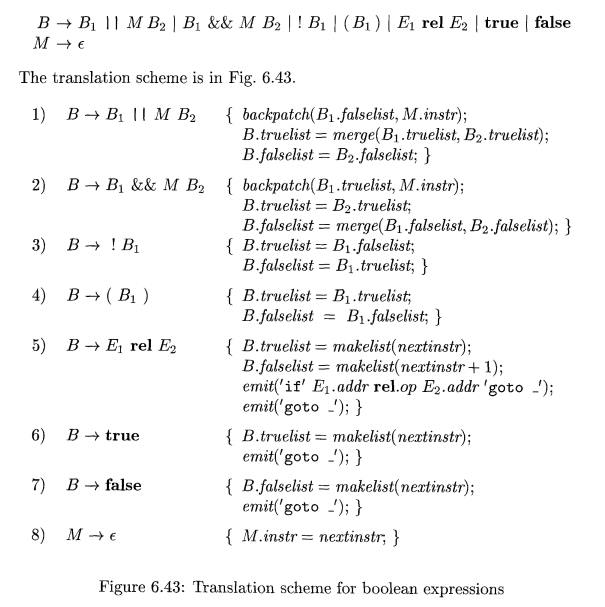
Consider semantic action (1) for the production B -> B1 || M B2. If Bx is true, then B is also true,
so the jumps on Bi.truelist become part
of B.truelist. If Bi is false, however, we must next test B2, so the target for the jumps B>i .falselist must be the
beginning of the code generated for B2 • This target is obtained using the
marker nonterminal M. That nonterminal produces, as a synthesized attribute
M.instr, the index of the next instruction, just before B2 code starts being
generated.
To obtain that instruction index, we associate with the production M -»
e the semantic action

The variable nextinstr holds the index of the next instruction to
follow. This value will be backpatched onto the Bi.falselist (i.e., each
instruction on the list B1.falselist will receive M.instr as its target label)
when we have seen the remainder of the production B ->• B1 || M B2.
Semantic action (2) for B -» B1 && M B2 is similar to (1). Action (3)
for B -> ! B swaps the true and false lists. Action (4) ignores parentheses.
For simplicity, semantic action (5) generates two instructions, a
conditional goto and an unconditional one. Neither has its target filled in.
These instructions are put on new lists, pointed to by B.truelist and
B.falselist, respectively.
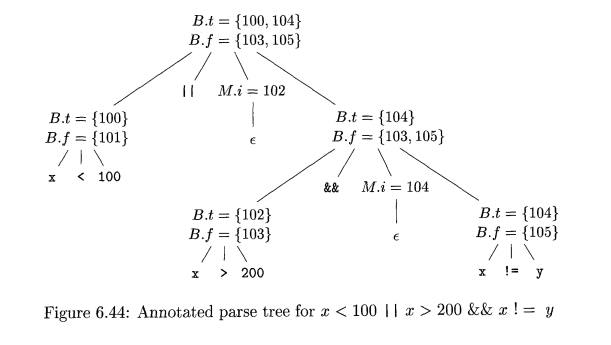
Example
6.24 :
Consider again the expression

An annotated parse tree is shown in Fig. 6.44; for readability,
attributes tru-elist, falselist, and instr are represented by their initial
letters. The actions are performed
during a depth-first traversal of the tree. Since all actions appear at the
ends of right sides, they can be performed in conjunction with reductions
during a bottom-up parse. In response to the reduction of x < 100 to B by
production (5), the two instructions

are generated. (We arbitrarily start instruction numbers at 100.) The
marker nonterminal M in the
production

records the value of nextinstr,
which at
this time is 102. The
reduction of x > 200 to B by
production (5) generates the instructions

The marker nonterminal M records the current value of nextinstr,
which is now
Reducing x ! = y into B by production (5) generates

We now reduce by B —> B1 && M B2. The corresponding semantic action
calls backpatch(B1.truelist,M.instr) to bind the true exit of B1 to the first
instruction of B2. Since B1.truelist is {102} and M.instr is 104, this call to
backpatch fills in 104 in instruction 102. The six instructions generated so
far are thus as shown in Fig. 6.45(a).
The semantic action associated with the final reduction by B —> B1 || MB2
calls backpatch({101},102) which leaves the instructions as in Fig. 6.45(b).
The entire expression is true if and only if the gotos of instructions
100 or 104 are reached, and is false if and only if the gotos of instructions
103 or 105 are reached. These instructions will have their targets filled in
later in the compilation, when it is seen what must be done depending on the
truth or falsehood of the expression.
3. Flow-of-Control Statements
We now use backpatching to translate flow-of-control statements in one
pass. Consider statements generated by the following grammar:

Here S denotes a statement, L a
statement list, A an assignment-statement, and B a boolean
expression. Note that there must be
other productions, such as
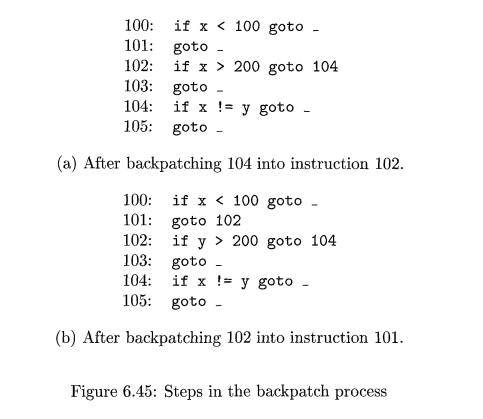
those for assignment-statements. The productions
given, however, are sufficient to illustrate the techniques used to translate
flow-of-control statements.
The code layout for if-, if-else-, and
while-statements is the same as in Section 6.6. We make the tacit assumption
that the code sequence in the instruction array reflects the natural flow of
control from one instruction to the next. If not, then explicit jumps must be
inserted to implement the natural sequential flow of control.
The translation scheme in Fig. 6.46 maintains lists
of jumps that are filled in when their targets are found. As in Fig. 6.43, boolean
expressions generated by nonterminal B
have two lists of jumps, B.truelist
and B.falselist, corresponding to the
true and false exits from the code for B,
respectively. Statements gener-ated by nonterminals 5 and L have a list of unfilled jumps, given by attribute nextlist, that must eventually be
completed by backpatching. S.nextlist is
a list of all conditional and
unconditional jumps to the instruction following the code for statement S in execution order. L.nextlist is defined similarly.
Consider the semantic action (3) in Fig. 6.46. The code layout for
production 5 -» while (B) S1
is as in Fig. 6.35(c). The two occurrences of the marker nonterminal M in the production

record the instruction numbers of the beginning of the code for B and the beginning of the code for Si. The corresponding labels in Fig.
6.35(c) are begin and B.true, respectively.
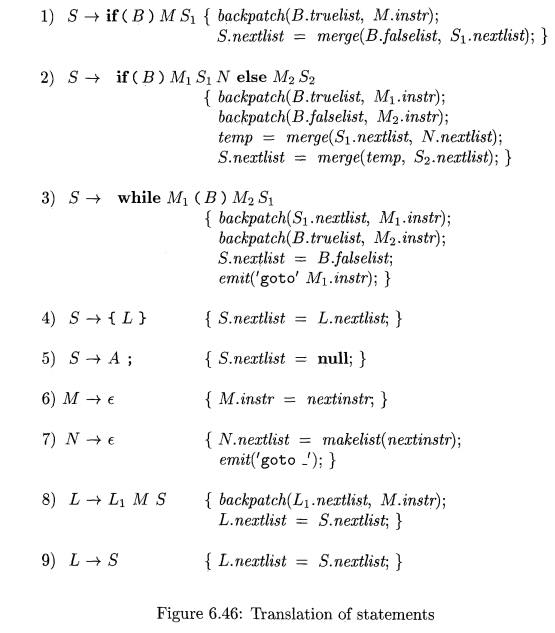
Again, the only production for M is M -> e. Action (6) in Fig. 6.46
sets attribute M.instr to the number
of the next instruction. After the body Si
of the while-statement is executed, control flows to the beginning. Therefore,
when we reduce while Mi (B ) M2 S1 to S, we backpatch Sy.nextlist to make all targets on that
list be My.instr. An explicit jump to
the beginning of the code for B is
appended after the code for Si
because control may also "fall out the bottom." B. truelist is backpatched to go to the beginning of Si by making jumps on B.truelist go to M2.instr.
A more compelling argument for using S.nextlist and L.nextlist comes
when code is generated for the conditional statement if ( B ) Si else S2. If
control "falls out the bottom" of Si, as when Si is an assignment, we
must include at the end of the code for Si a jump over the code for S2- We use
another marker nonterminal to generate this jump after Si. Let nonterminal N be
this marker with production N -> e. N has attribute N.nextlist, which will
be a list consisting of the instruction number of the jump goto _ that is
generated by the semantic action (7) for N.
Semantic action (2) in Fig. 6.46 deals with if-else-statements with the
syntax

We backpatch the jumps when B is true to the instruction Mi.instr; the
latter is the beginning of the code for Si. Similarly, we backpatch jumps when
B is false to go to the beginning of the code for S 2 . The list S.nextlist
includes all jumps out of Si and S 2 , as well as the jump generated by N.
(Variable temp is a temporary that is used only for merging lists.)
Semantic actions (8) and (9) handle sequences of statements. In

the instruction following the code for L± in order of execution is the
beginning of S. Thus the L1.nextlist list is backpatched to the beginning of
the code for S, which is given by M.instr. In L —> S, L.nextlist is the same
as S.nextlist.
Note that no new instructions are generated
anywhere in these semantic rules, except for rules (3) and (7). All other code
is generated by the semantic actions associated with assignment-statements and
expressions. The flow of control causes the proper backpatching so that the
assignments and boolean expression evaluations will connect properly.
4. Break-,
Continue-, and Goto-Statements
The most elementary programming language construct for changing the flow
of control in a program is the goto-statement. In C, a statement like goto L
sends control to the statement labeled L — there must be precisely one
statement with label L in this scope. Goto-statements can be implemented by
maintaining a list of unfilled jumps for each label and then backpatching the
target when it is known.
Java does away with goto-statements. However, Java does permit
disci-plined jumps called break-statements, which send control out of an
enclosing construct, and continue-statements, which trigger the next iteration
of an en-closing loop. The following excerpt from a lexical analyzer
illustrates simple break- and continue-statements:

Control jumps from the break-statement On line 4 to the next statement
after the enclosing for loop. Control jumps from the continue-statement on line
2 to code to evaluate readch() and
then to the if-statement on line 2.
If 5 is the enclosing construct, then a break-statement is a jump to the
first instruction after the code for S.
We can generate code for the break by (1) keeping track of the enclosing
statement S, (2) generating an
unfilled jump for the break-statement, and (3) putting this unfilled jump on S.nextlist, where nextlist is as discussed in Section 6.7.3.
In a two-pass front end that builds syntax trees, S.nextlist can be imple-mented as a
field in the node for S. We can keep
track of S by using the symbol table
to map a special identifier b r e a k to the node for the enclosing statement S. This approach will also handle
labeled break-statements in Java, since the symbol table can be used to map the
label to the syntax-tree node for the enclosing construct.
Alternatively, instead of using
the symbol table to access the node for 5, we can put a pointer to S.nextlist in the symbol table. Now,
when a break-statement is reached, we generate an unfilled jump, look up nextlist through the symbol table, and
add the jump to the list, where it will be backpatched as discussed in Section
6.7.3.
Continue-statements can be
handled in a manner analogous to the break-statement. The main difference
between the two is that the target of the gen-erated jump is different.
5. Exercises for Section 6.7
Exercise 6.7.1 : Using the translation of Fig. 6.43, translate each of
the fol-lowing expressions. Show the true and false lists for each
subexpression. You may assume the address of the first instruction generated is
100.
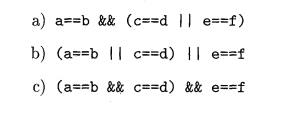
E x e r c i s e 6 . 7 . 2 : In Fig. 6.47(a) is the outline of a program,
and Fig. 6.47(b) sketches the structure of the generated three-address code,
using the backpatch-ing translation of Fig. 6.46. Here, ix through i8 are the labels of the generated instructions that begin each of the
"Code" sections. When we implement this translation, we maintain, for
each boolean expression E, two lists
of places in the code for E, which we
denote by E.true and E.false. The places on list E.true are those places where we
eventually put the label of the statement to
which control must flow whenever E
is true; E.false similarly lists the
places where we put the label that control flows to when E is found to be false. Also,
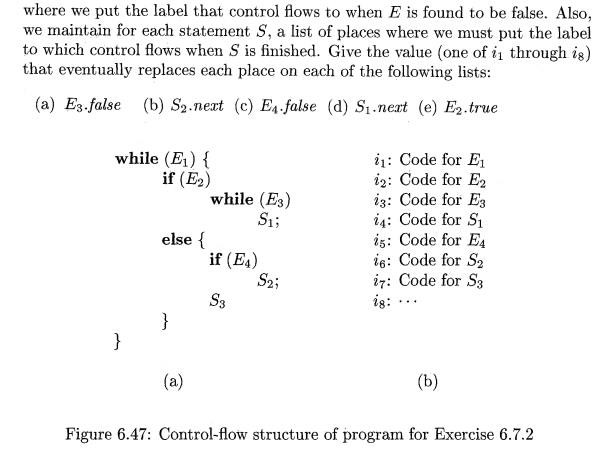
Exercise 6 . 7 . 3 : When performing the translation of Fig. 6.47 using the
scheme of Fig. 6.46, we create lists
S.next for each statement, starting
with the assign-ment-statements Si, S 2 , and S 3 , and proceeding to
progressively larger if-statements, if-else-statements, while-statements, and
statement blocks. There are five constructed statements of this type in Fig.
6.47:
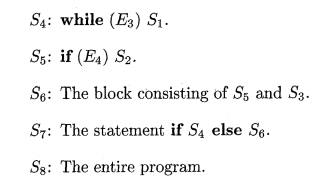
For each of these constructed statements, there is a rule that allows us
to construct Sj.next in terms of other Sj.next lists, and the lists Ek.true and
Ek-false for the expressions in the program. Give the rules for

Related Topics